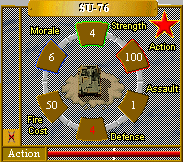
|
| Victory Points |
Armour | Start | Start | End | End | ||
| Front | Side | Rear | Month | Year | Month | Year | |
| 4 | 4 | 1 | 1 | 2 | 43 | 5 | 45 |
| SU-76M Light Self-propelled Gun | ||||||||||||||||||||
| RANGE | 1 | 2 | 3 | 4 | 5 | 6 | 7 | 8 | 9 | 10 | 11 | 12 | 13 | 14 | 15 | 16 | 17 | 18 | 19 | 20 |
| HARD | 18 | 16 | 14 | 13 | 7 | 4 | . | . | . | . | . | . | . | . | . | . | . | . | . | . |
| SOFT | 12 | 12 | 11 | 11 | 10 | 9 | 8 | 8 | 7 | 7 | 6 | 6 | . | . | . | . | . | . | . | . |

|
SU-76M Light Self-propelled Gun
|
Specification |
|
The first Soviet self-propelled gun combined a 76.2 mm (3 in) ZiS-3 field gun with a lengthened T-70 light tank chassis.The gun was mounted in an armored box.The chassis was fitted with an extra road wheel.Known as the SU-76M Light Mechanized Gun it went on to be the most numerous of all World War II Soviet armored vehicles apart from the T-34 tank series. Mass production began in early 1943 although few were action before 1944.Early examples had mechanical troubles due to drive arrangements that had already proved unworkable on the early T-70 light tanks.Although intended to double as a tank destroyer and issued with limited quantities of armour-piercing ammunition , the SU-76M primarily served as an assault gun.Its gun could fire the same ammunition as other Soviet 76.2 mm (3 in) field guns and a high-velocity solid shot was developed to penetrate enemy armour. Despite its widespread employment the SU-76M was never a popular vehicle with its crews.The armored superstructure was open at the top and rear so the crew were vulnerable to attack and had no protection against the elements.The SU-76M went on to a long post-war career serving with many nations until well into the late 1980s. |